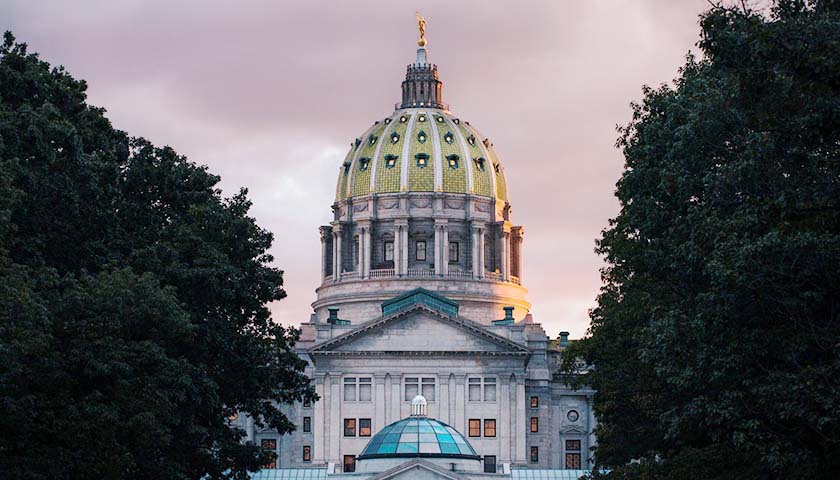Pennsylvania’s Republican-led state Senate and Gov. Tom Wolf (D) must approve a congressional map Monday in order to meet a deadline set by the Pennsylvania Department of State.
Last summer, then-Secretary of the Commonwealth Veronica Degraffenried (D) announced that her department wanted new congressional districts enacted before January 24 so election officials and candidates may adequately prepare for the May 17, 2022 primaries. Lawmakers redesign districts every decade according to population changes reflected in U.S. Census data, whose release last year stalled several months owing to the COVID-19 pandemic. Population trends dictate that the Keystone State will lose one congressional district out of its present eighteen.
Earlier this month, he Pennsylvania state House of Representatives passed a largely citizen-drawn congressional map and the Senate State Government Committee advanced that map to the full chamber where it awaits consideration. Wolf has, however, expressed his disapproval of that plan, insisting that it contains unnecessary divisions of counties, municipalities and other communities “that do not appear to be motivated by compelling legal principles, but rather by a desire to make districts more favorable to Republican candidates.”
On Friday, the Senate committee held a public hearing on two remapping plans Wolf has said he would sign, one drawn by his office and another designed by Draw the Lines PA, a subgroup of the Committee of Seventy, a left-leaning, Philadelphia-based nonprofit. Those maps similarly received criticism by Republicans on the panel.
Majority Chairman David Argall (R-Schuylkill) took aim at what he called an “artificial division” of Pittsburgh, a Democrat-heavy city.
“To some, that looks like an overly partisan act,” he said. “To others, it would appear to divide … communities of interest.”
Among the witnesses at the hearing were Pennsylvania State University demographer Christopher Fowler and West Chester University political scientist John J. Kennedy, both members of the governor’s Pennsylvania Redistricting Advisory Council. Both men testified to not having participated in creating the governor’s congressional redistricting plan. Republican senators lamented the fact that Wolf had not revealed who helped to craft his proposed map.
Albert Eisenberg, co-founder and digital director of the Philadelphia-based webzine Broad + Liberty, told committee members that Wolf’s map undoubtedly results from the governor’s political bent. As evidence, he cited Wolf’s preference for splitting Bucks County which is within the First Congressional District currently represented by Brian Fitzpatrick. A moderate Republican, Fitzpatrick has been targeted by Democrats ever since winning his seat in 2016.
“We have a governor’s map that specifically kneecaps one incumbent in what is now the First Congressional District which is based in Bucks County,” Eisenberg said. “There is no reason to exclude the most working-class and Republican-leaning precincts in lower Bucks County except in order to include a greater portion of purple and blue Montgomery County…. The only reason to do this is because Brian Fitzpatrick has happened to win office even with an ‘R’ next to his name and outperformed President Trump by about 17 points….”
Eisenberg also criticized the map created by Draw the Lines PA for featuring district lines that would facilitate electing 10 Democrats and seven Republicans in a state that is roughly evenly split between members of the two parties.
Justin Villere, managing director of Draw the Lines PA, disputed Eisenberg’s characterization of the map as favorable to Democrats, arguing that modeling for potential 2022 election outcomes should be based mainly on results of the 2016 election in which Republicans saw much success. He suggested ignoring data from the 2018 midterm elections which were more favorable to Democrats.
If lawmakers don’t clinch reapportionment one week after the State-Department deadline, the Republican-controlled Commonwealth Court is poised to pick a map from among those proposed. If Democrats choose to litigate the matter beyond that, the matter could come before the Democrat-controlled state Supreme Court, which took it upon itself to redraw congressional district lines in 2018.
– – –
Bradley Vasoli is managing editor of The Pennsylvania Daily Star. Follow Brad on Twitter at @BVasoli. Email tips to [email protected].
Photo “Pennsylvania State Capitol” by Governor Tom Wolf CC BY 2.0.








